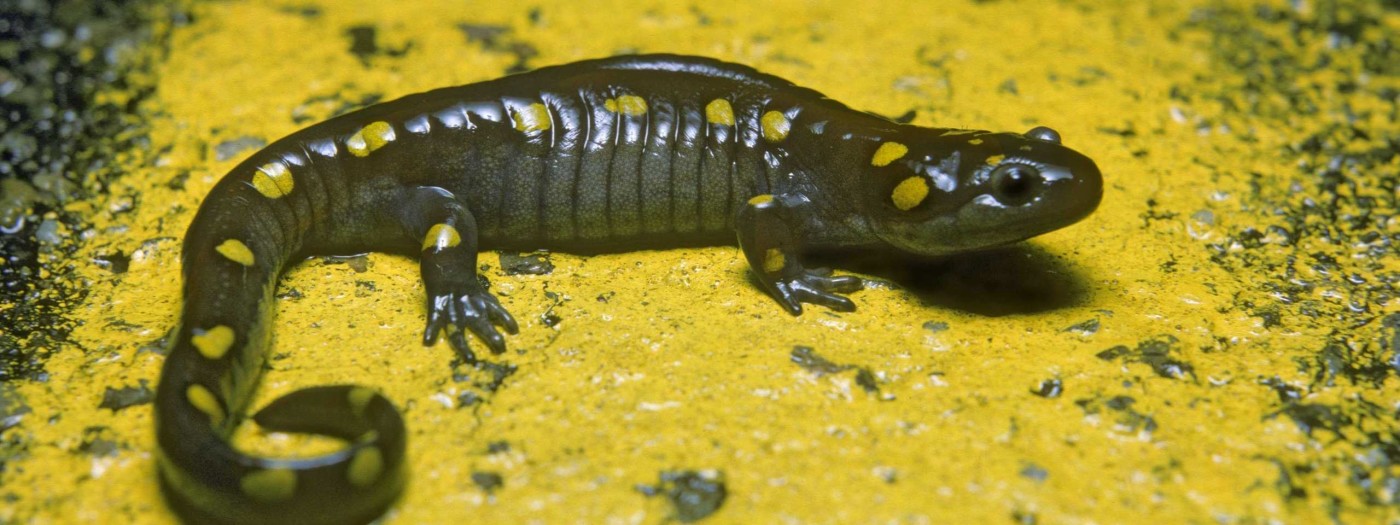Animals and Plants of the Finger Lakes
The Elusive Spotted Salamander
The spotted salamander, Ambystoma maculatum, is a secretive denizen of eastern U.S. and southern Canadian woodlands.
Although its looks are arresting — two rows of bright yellow spots on a dark body as long as your hand — it is all but invisible most of the year. Like all so-called “mole salamanders,” spotted salamanders spend most of their time underground in burrows that they find or dig themselves.
However, for a very short window of time in the spring, this reclusive animal comes out of hiding. Small depressions in the ground, dry or covered with snow for most of the year, fill with spring rains and form vernal pools. These ephemeral wetlands can’t support hungry fish, so they are perfect breeding ponds for species like mole salamanders, wood frogs, and fairy shrimp.

Responding to some signal — perhaps the temperature, or the flooding of their burrows, or even the sound of raindrops on the surface — on the first warm nights of spring, the spotted salamanders start to emerge and begin a synchronized migration toward the vernal pools of their birth, sometimes passing by perfectly good breeding ponds on the way.
How do they know where to go? Scientists can’t say for certain, but Kraig Adler, Cornell Professor of Biology, offers a guess: “They probably use odors and the Earth’s magnetic field to orient, as do newts.”
The salamanders stay at their natal pools only long enough to mate and lay their eggs before returning home. The larvae remain in the ponds for several months, feeding on tiny invertebrates, until they trade their gills for lungs and grow legs that allow them to follow their parents on land. By this time, the vernal pools have dried up, reverting back to unobtrusive hollows in the forest floor. It may take more than five years before a juvenile reaches sexual maturity, but spotted salamanders can live more than thirty years.

The population of spotted salamanders in Tompkins County is healthy, thanks to good conservation practices. However, in other parts of the state, their status is precarious enough that they are listed as a “Special Concern Species” by the New York State Department of Environmental Conservation. One threat that these animals face is the destruction of their breeding ponds. Since vernal pools are shallow and dry most of the year, they are often filled in or built over by homeowners and developers.
Another problem is water pollution, to which salamanders are exquisitely sensitive. Heavy metals and pesticides are deadly, but acid rain and snow are bigger threats in the northeast. Salamander eggs and larvae either die or develop abnormally if the pH of their ponds is too low. The Adirondacks in particular have been deeply affected by pollution: some lakes and ponds there have become so acidic that they cannot support normal aquatic ecosystems.
Perhaps the most obvious, and in some ways the most easily addressed, threat to salamanders is automobile traffic. A heavily used road that cuts across a migration path can decimate a salamander population, and the amphibians are small enough to escape the notice of all but the most eagle-eyed motorist. Since neither human roads nor salamander migrations can be easily re-routed, one way to prevent a conflict of interests is to build road underpasses (sometimes called “toad tunnels”) or modify already existing culverts. The Cornell Plantations took the latter approach, building an animal directional fence that shepherds migrating amphibians into a culvert beneath Ringwood Road in Ithaca. Nancy Ostman, the Plantations Natural Areas Program Director, reports that although the toad tunnel has been quite successful, “there are still a cluster of deaths off of the end of the fence. Some animals will go the wrong way even if it is out of the way.” The Plantations also manages ponds near the Cornell golf course that are used by breeding amphibians. Because debris from road and golf course maintenance tends to collect in these ponds, the Plantations staff regularly dredges their perimeters, thereby ensuring that the water is deep enough for the amphibians to breed and the young to survive.
This spring, look — and drive! — carefully, and if you’re lucky, you might catch a glimpse of the slow, inexorable vernal march of the spotted salamander.
This story by Jacqueline Stuhmiller first appeared in our newsletter, The Land Steward, as part of the Closer Look series.





